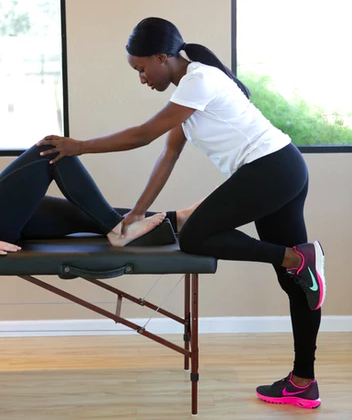Dance Well, Live Well
Wellness blog for dance medicine, holistic health, and more
Repost from Feb 2021
Top 3 Causes of Knee Tightness and Pain in Dancers

Knee issues are one of the most frequent complaints we get from our clients, but not all knee symptoms are for the same reason. We’ll run down the top 3 reasons behind knee issues in dancers and clue you in on solutions to get you back on your feet in no time! : )
1. Knee muscles are busy doing something else.
The two major muscles which control knee movement are the quadriceps and the hamstrings, which we’re sure you know. The concept of compensation is simple: Muscles can typically perform multiple actions to create movement, but they typically can only perform one action at a time.
For example, if a dancer is “gripping” their quads to aid in holding the leg in the air, then the quad is being used a little more for hip flexion at that point and may not generate enough power to straighten the knee as well. The hamstrings often tighten up and remain locked as a source of strength and stability to compensate for core weakness, meaning it’s unable to bend the knee effectively when needed. In both of these situations, there’s less power from each muscle to control the action of the knee and the placement of the kneecap, which can cause pain and tightness in the knee.
2. Hip tightness or instability.
Tightness and weakness in the hip can send unbalanced movement forces into the knee joint, creating pain and instability. Hip issues especially occur regarding the balance between internal and external rotation, regardless of the style of dance. (Every dance style uses turnout in some way.)
Tightness in the hip as a compensation for core instability, or weakness in the muscles in the face of a difficult position or motion can transmit excessive forces into the knee which should be handled by the hip, but can’t. This can pull the kneecap into imbalanced positions, causing pain, tightness, or even popping sensations. Muscle imbalances in the hip are often related to knee dislocations as well.
3. Abdominal issues
This is the area that flies under the radar, but is frequently a source recurring or persistent knee pain, pain or tightness that doesn’t go away with exercise. Fascial tightness from irritated or overwork organs can actually cause knee pain. How???
Fascia the connective tissue that connects different regions of the body. It wraps around each abdominal organ to keep it in the abdominal cavity, but also attaches the ribs, hips, and side of the knees to keep things anchored in place even more. So, things like decreased water intake, too much sugar, menstrual issues, and constipation can change the shape and movement of the internal organs. This will change tension of the fascia and can trickle down into the knee area, causing pain and irritation.
So what can you do to fix your knee pain?
The answer is always to tackle the symptom at its source. So here are some things to consider:
1. If you know that you tend to grip in your quads for leg elevation, look for weakness in internal and external rotators of the hip. Exercises like standing hip abduction, fire hydrants, and side planks can improve rotational strength (and a little core stability) which may help reduce strain and pain to the knee.
2. If you struggle with turnout or hip popping and tightness, this may be a compensation for instability of the lower core. Look to increase core stability, which will allow the hip to return to normal function (flexion, extension, rotation) and transmit the correct amount and direction of force into the knee when dancing. Planks in various positions, single leg bridges, and activation of core stabilizers for rotation can definitely help.
3. If you have abdominal symptoms such as constipation, upset stomach, irregular or excessive menstrual issues, urinary symptoms, or know that you could stand to eat a little healthier, try a heating pad and belly massage for a few days and see if that affects your knee pain in any way. Regardless of whether it makes your symptom better or worse, a change means that area is a factor in your knee function, so getting help to resolve any issue in the abdomen will definitely help the knee.
Exercises and Tips
Here are some links to basic exercises to try for improved core stability, hip strength and abdominal mobility. Make sure to post and tag @azdancemed with any exercises that you try. DM us on Facebook or Instagram with any questions related to the content in this post.
AZDM Top Exercises: https://youtu.be/VaOQSFjyrKM
Rotation Activation exercise: https://youtu.be/pbO6X2LoRa4
Abdominal release: https://youtu.be/RGhbjGU84RM
Want help from AZDM for your knee pain or another issue keeping you from dancing your best? Message us at info@azdancemed.com and let us know what you’re struggling with. If you’re serious about getting help you can schedule a free discovery session at our Phoenix clinic or online and we will create a custom plan to help you achieve your goals. CLICK HERE to schedule.
As always, know that we can help and we are here for you.
Our mission is to help everyone who reaches out to us live their most amazing life.
But we can't help, if you don't let us know you need us. We look forward to hearing from you soon.
Not a dancer? No problem. We can help you too. Click HERE.
AZ Dance Medicine Specialists
info@azdancemed.com | 602.730.4159